Shuttles, Cars, or Trails? State Offers Menu of Options for Hollister Ranch Beach Access
Draft Report Examines Pros and Cons of Possibilities

A smorgasbord of options for opening Hollister Ranch’s six prized beaches to the public was unveiled this week, marking the first time in the decades-long debate over access that concrete proposals are being openly discussed.
The lengthy menu is part of a 49-page Draft Conceptual Program published Thursday by the California Coastal Commission, one of four state agencies tasked with negotiating and formulating a final plan. A public Zoom workshop to review the report and solicit feedback is scheduled for 5:30 p.m. this Wednesday.
The draft program offers three main methods by which people might cut across the private ranch, a 14,000-acre working cattle operation and one of the last undeveloped sections of Southern California shoreline, to reach the public beaches below its steep coastal bluffs ― by shuttle, car, or trail, all either independently or guided.
Each option has its own distinct set of pros and cons, the report states, including environmental impacts, costs and infrastructure needs, interactions with Chumash cultural sites, and effects on the homeowners living across 135 individual parcels.
A free or low-cost shuttle service, for instance, would provide the most equitable access to the beaches, which the Coastal Commission notes more than once are a public resource to be enjoyed by all. It might also be the safest, as shuttle drivers would be familiar with the hazards of the ranch’s only road, including its sharp turns and drops and frequent obstruction by cattle. But funding could be a problem, the agency acknowledged, as even in State Parks with very high visitor numbers, user fees are generally not enough to cover costs.
Drive-in access by personal car would be the most flexible and inclusive for visitors of varying physical abilities, the Commission continued. But the necessary parking and traffic control measures would also likely represent the heaviest impacts to private property and coastal resources.
A multi-use trail system for hikers, bicyclists, and equestrians would give users an up-close and personal view of the ranch’s ruggedly beautiful terrain. Enhanced access rights from multiple owners would be required, however, and steep topography might make construction especially difficult and expensive, the Commission said.
The various proposals are sure to elicit a range of reactions from both Hollister residents and members of the public anxious to visit the virtually untouched stretch of coast. Some will say the state goes too far with its ideas. Others will say it doesn’t go far enough.
For his part, Ed De La Rosa, board chair of the Hollister Ranch Owners’ Association, called the draft report “a pretty ambitious vision” for the future of the historic property. He said he recognized, however, the difference between its more aspiring and its more feasible elements, given the constitutionally protected rights of the owners.
De La Rosa said he appreciated the state’s recognition of how “biologically and geographically special the Ranch really is,” especially taken alongside the adjacent Dangermond Preserve. “It represents a huge wildlife corridor,” he said. The report notes the presence of the federally endangered Gaviota tarplant, as well as protected animal species like the Coastal Range newt, western pond turtle, and two-striped garter snake.
De La Rosa was also encouraged by the consideration of the region’s many Chumash sites and the Coastal Commission’s clearly stated mission to introduce members of underserved communities to the wonders of nature. Most significantly, he said, the agency acknowledged how important ongoing conversations with the property owners remain. “The state, to its credit, points out a lot of logistical considerations that they need to talk to homeowners about,” he said.
Doug Kern, director of the Gaviota Coast Conservancy and a member of the draft proposal’s working group, said he was “really actually optimistic” about how the report will be received, “given all the potential for difficulty.” On every side of the debate are “different personalities and interests and significant tensions,” yet “everyone is doing their best to thread a needle here,” Kern said. “I give everyone credit for coming to the table.”
The road ahead remains long, Kern continued, with any new overland access still likely a year or two out, especially with the delays to the process that the pandemic brought. Whatever final form the plan takes, it will be “limited, managed, and not hugely expensive,” Kern assured, and nothing will be set in stone given the unforeseen challenges that come from working with Mother Nature, “who always bats last.” “We will try everything in a careful way,” he said, “see what happens, and make adjustments.”
Support the Santa Barbara Independent through a long-term or a single contribution.



